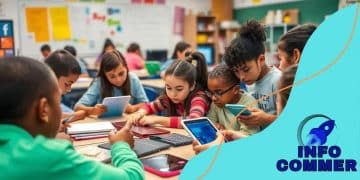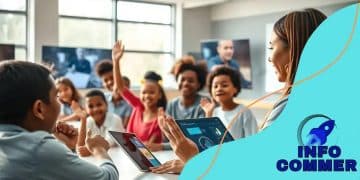Gamified learning systems in the classroom: transforming education

Gamified learning systems enhance student engagement and motivation by incorporating game mechanics into educational experiences, fostering collaboration, personalized learning, and critical thinking skills while addressing potential challenges such as resistance to change and resource limitations.
Gamified learning systems in the classroom are changing how students engage with material. Have you ever wondered how games can make learning more fun and effective? In this article, we’ll delve into the impact of gamification on student success and motivation.
Understanding gamified learning systems
Understanding gamified learning systems is essential for modern education. These systems integrate game elements into the learning process, making lessons more engaging. Students often find traditional methods less motivating. By using gamified learning systems, teachers can turn lessons into exciting challenges that foster a love for learning.
Key Components of Gamified Learning
Gamified learning systems typically include several key components that enhance the learning experience. These components help create a dynamic classroom atmosphere.
- Points and Awards: Students earn points for completing tasks, which can be exchanged for rewards.
- Leveling Up: As students progress, they move to higher levels, making their achievements more visible.
- Challenges: Introducing challenges that require critical thinking keeps students engaged.
- Leaderboards: Displaying progress on leaderboards fosters a healthy competitive spirit among students.
Incorporating these elements in the classroom can transform education. When students see learning as a game, they are more likely to participate actively. They tend to take ownership of their learning journey, leading to better outcomes. The idea is to make education feel rewarding rather than stressful.
Benefits of Understanding These Systems
By understanding gamified learning systems, educators can design personalized experiences. They can identify what motivates their students and tailor activities accordingly. This level of customization is crucial in addressing diverse learning styles.
Moreover, teachers can use data from these systems to gain insights into student performance. Monitoring progress allows for timely interventions, ensuring that no student falls behind. Additionally, it helps build a supportive community where students feel encouraged to explore new concepts.
Overall, strong comprehension of gamified learning systems empowers educators to create an interactive, supportive environment. Embracing these innovative approaches can revolutionize how students engage with their studies and develop skills needed for the future.
Benefits of gamified learning in classrooms
The benefits of gamified learning in classrooms are significant and can transform how students engage with their education. By incorporating game mechanics, educators can create a more interactive learning environment. This approach not only motivates students but also enhances their overall learning experience.
Enhanced Engagement
One of the primary advantages of gamified learning is its ability to boost student engagement. Traditional lessons can sometimes feel monotonous. However, when learning becomes a game, students often show increased enthusiasm. They participate more actively and demonstrate a willingness to explore new concepts.
- Encouraging Participation: Students are more likely to join discussions and collaborate on projects.
- Increased Retention: Gamified elements like quizzes and challenges help reinforce learning, making retention easier.
- Personalized Learning: Learners can progress at their own pace, tailoring their experience to their individual needs.
Moreover, this level of involvement leads to improved academic performance. When learning feels like play, students are less intimidated by challenges and more willing to tackle difficult subjects.
Development of Critical Skills
Gamified learning also fosters the development of important skills. Students are challenged to think critically and solve problems, which are essential skills for their future. As they navigate through levels and quests, they practice decision-making and strategic thinking.
These skills are not only beneficial in the classroom, but they also prepare students for real-world scenarios. For instance, working in teams to achieve goals helps develop collaboration and communication skills. These are vital in any career path students may choose.
Building a Strong Community
Another benefit of gamified learning is the sense of community it fosters among students. When working together on gamified tasks, they build strong relationships. Collaborative environments encourage students to support each other, promoting a positive classroom culture.
This camaraderie can lead to higher levels of self-confidence. Students feel more comfortable sharing their ideas and taking creative risks within a supportive group. Overall, gamified learning in classrooms cultivates not just academic knowledge but also social skills.
Designing effective gamified learning experiences

Designing effective gamified learning experiences involves careful planning and creativity. The goal is to create a learning environment where students feel motivated and excited to participate. Let’s explore key elements that contribute to successful gamification in education.
Understanding Your Learners
The first step in creating a gamified learning experience is understanding the needs and interests of your students. Each class is unique, so tailoring gamified elements to their preferences can enhance engagement. For example, consider their age, interests, and learning styles.
- Surveys and Feedback: Use surveys to gather information about what students enjoy in lessons.
- Incorporating Interests: Use themes that resonate with students, such as popular games or movies.
- Flexibility: Allow students to choose their learning paths based on their interests.
By understanding what drives your students, you can design experiences that resonate with them, keeping their motivation high.
Integrating Game Mechanics
Next, integrating game mechanics into the learning process is crucial for creating an effective gamified experience. This can include points, levels, badges, and leaderboards. These elements motivate students to achieve and participate actively in their learning.
For instance, awarding points for completing tasks encourages friendly competition. Leaderboards can showcase top performers, while badges serve as tangible rewards for achievements. Such mechanics can significantly boost a sense of accomplishment among students.
It’s essential to balance competition and cooperation. Some tasks can be designed for individual competition, while others can encourage teamwork, fostering a supportive learning environment.
Creating Meaningful Challenges
Another important aspect is designing meaningful challenges that stretch students’ abilities but remain achievable. These challenges should promote critical thinking, problem-solving, and teamwork. Providing a variety of tasks allows different learners to shine.
- Progressive Complexity: Start with simple tasks and gradually increase difficulty to build confidence.
- Real-World Applications: Incorporate challenges that relate to real-life scenarios to make learning relevant.
- Immediate Feedback: Offer feedback on tasks to help students learn from mistakes and improve.
When challenges align with learning objectives and provide constructive feedback, students are more likely to engage deeply with the content.
By focusing on these key components, educators can create effective gamified learning experiences that not only enhance engagement but also lead to better educational outcomes. Each step—understanding learners, integrating game mechanics, and creating challenges—plays a vital role in developing a fun and educational environment.
Challenges when implementing gamification in education
Challenges when implementing gamification in education can arise due to various factors. While gamification offers many benefits, educators must navigate obstacles that might affect its success. Identifying these challenges is the first step toward implementing effective strategies.
Resistance to Change
One major challenge is resistance to change among educators and students. Teachers may be comfortable with traditional teaching methods and hesitant to adopt new strategies. Some might believe that gamification is not serious or effective.
- Teacher Training: Proper training is crucial to help teachers understand gamification’s value and features.
- Student Attitudes: Some students might view gamified elements as childish, leading to resistance in participation.
- Time Constraints: Teachers often have limited time to plan lessons, making it hard to incorporate new techniques.
Addressing resistance involves providing support and demonstrating the effectiveness of gamification in enhancing learning outcomes.
Resource Limitations
Another challenge is the availability of resources. Implementing gamified learning requires access to technology and materials that may not be available in all schools. Technological limitations can hinder the design of engaging experiences for students.
In some cases, teachers may not have access to software or devices necessary for gamification. Schools need to prioritize investment in educational technology to overcome these limitations and ensure all students can benefit from gamified experiences.
Balancing Competition and Collaboration
Finding the right balance between competition and collaboration is crucial. While some level of competition can motivate students, excessive rivalry may create anxiety and discourage participation. Educators need to design activities that promote teamwork alongside healthy competition.
- Inclusive Activities: Create tasks that encourage students to work together while still recognizing individual achievements.
- Focus on Learning: Emphasize personal growth and understanding over winning or losing.
- Celebrate Team Success: Highlight team accomplishments to foster a sense of community.
By carefully designing gamified elements, educators can create an environment that supports both competition and collaboration.
Overall, being aware of the challenges when implementing gamification in education allows educators to prepare adequately. With the right strategies, they can effectively overcome these challenges and create enriching learning experiences.
Future trends in gamified learning systems
Future trends in gamified learning systems are shaping the way education is evolving. As technology advances, new possibilities arise for enhancing student engagement and learning outcomes. By understanding these trends, educators can stay ahead and optimize their teaching methods.
Increased Use of Artificial Intelligence
One major trend is the integration of artificial intelligence (AI) in gamified learning. AI can analyze student data to create personalized learning experiences. This technology tailors challenges and rewards based on individual performance.
- Adaptive Learning: AI can provide real-time feedback and adjust the difficulty of tasks.
- Customizable Content: Teachers can use AI tools to create unique gamified elements that align with their curriculum.
- Predictive Analytics: AI can forecast student performance and highlight areas needing support.
With AI, the learning process becomes more interactive, allowing students to progress at their own pace while enjoying the journey.
Virtual and Augmented Reality
Another exciting trend is the use of virtual reality (VR) and augmented reality (AR). These technologies offer immersive learning experiences that can enhance gamification.
For example, students can take virtual field trips or participate in simulated environments related to their studies. This level of engagement creates memorable learning moments that traditional methods cannot provide.
Utilizing VR and AR can lead to higher retention rates. The interactive nature of these technologies encourages students to actively participate, making lessons more enjoyable.
Integration of Social Learning Features
Future gamified learning systems will likely incorporate more social learning features. Collaborative tools will foster teamwork and communication among students, even in digital learning environments.
- Peer Interaction: Incorporating platforms where students can share their achievements and collaborate on challenges.
- Community Building: Creating forums or groups for students to discuss ideas and support each other.
- Celebrating Success: Implementing systems to recognize both individual and group achievements.
This creates a sense of community, encouraging students to support one another and enhancing their overall learning experience.
By embracing these future trends in gamified learning systems, educators can create dynamic and engaging environments. Keeping an eye on these developments ensures that teaching methods remain relevant and effective for upcoming generations.
FAQ – Frequently Asked Questions about Gamified Learning Systems
What are gamified learning systems?
Gamified learning systems are educational approaches that use game mechanics to enhance student engagement and motivation within the classroom.
How can gamification benefit students?
Gamification can boost student participation, increase retention of information, and promote teamwork and critical thinking skills.
What are some challenges in implementing gamified learning?
Challenges include resistance to change from both educators and students, resource limitations, and the need to balance competition with collaboration.
What future trends can we expect in gamified learning?
Future trends may include more use of AI for personalized learning experiences, integration of virtual and augmented reality, and enhanced social learning features.





